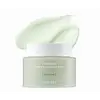What's inside
What's inside
 Key Ingredients
Key Ingredients

 Benefits
Benefits

 Concerns
Concerns

 Ingredients Side-by-side
Ingredients Side-by-side

Cetyl Ethylhexanoate
EmollientCaprylic/Capric Triglyceride
MaskingPolyglyceryl-6 Caprate
CleansingPolyglyceryl-10 Diisostearate
EmulsifyingSynthetic Wax
AbrasiveCaprylyl Glycol
EmollientSimmondsia Chinensis Seed Oil
EmollientEthylhexylglycerin
Skin ConditioningWater
Skin ConditioningButylene Glycol
HumectantMelia Azadirachta Leaf Extract
Skin ConditioningMelia Azadirachta Flower Extract
Skin ConditioningCoccinia Indica Fruit Extract
Skin ConditioningVitis Vinifera Fruit Extract
Skin ConditioningSolanum Melongena Fruit Extract
Skin ConditioningPyrus Malus Fruit Extract
Skin ConditioningPrunus Mume Fruit Extract
HumectantCarica Papaya Fruit Extract
Skin ConditioningAmber Powder
Ocimum Sanctum Leaf Extract
Skin ConditioningCurcuma Longa Root Extract
MaskingMoringa Oleifera Seed Oil
EmollientCorallina Officinalis Extract
Skin ConditioningPolyglyceryl-6 Polyricinoleate
EmulsifyingPolyglyceryl-6 Caprylate
EmulsifyingPolyglyceryl-4 Caprate
EmulsifyingPolyglyceryl-3 Cocoate
EmulsifyingMelaleuca Alternifolia Leaf Water
AntimicrobialMelaleuca Alternifolia Leaf Extract
Perfuming4-Terpineol
MaskingCetyl Ethylhexanoate, Caprylic/Capric Triglyceride, Polyglyceryl-6 Caprate, Polyglyceryl-10 Diisostearate, Synthetic Wax, Caprylyl Glycol, Simmondsia Chinensis Seed Oil, Ethylhexylglycerin, Water, Butylene Glycol, Melia Azadirachta Leaf Extract, Melia Azadirachta Flower Extract, Coccinia Indica Fruit Extract, Vitis Vinifera Fruit Extract, Solanum Melongena Fruit Extract, Pyrus Malus Fruit Extract, Prunus Mume Fruit Extract, Carica Papaya Fruit Extract, Amber Powder, Ocimum Sanctum Leaf Extract, Curcuma Longa Root Extract, Moringa Oleifera Seed Oil, Corallina Officinalis Extract, Polyglyceryl-6 Polyricinoleate, Polyglyceryl-6 Caprylate, Polyglyceryl-4 Caprate, Polyglyceryl-3 Cocoate, Melaleuca Alternifolia Leaf Water, Melaleuca Alternifolia Leaf Extract, 4-Terpineol
Water
Skin ConditioningGlycerin
HumectantCaprylic/Capric Triglyceride
MaskingCetearyl Alcohol
EmollientSodium Cocoyl Isethionate
CleansingMyristic Acid
CleansingCetearyl Olivate
Sodium Lauroyl Glutamate
Sorbitan Olivate
EmulsifyingPalmitic Acid
EmollientXanthan Gum
EmulsifyingStearic Acid
Cleansing1,2-Hexanediol
Skin ConditioningLauryl Glucoside
CleansingHydroxyacetophenone
AntioxidantDecyl Glucoside
CleansingButyrospermum Parkii Butter
Skin ConditioningDisodium EDTA
Niacinamide
SmoothingPanthenol
Skin ConditioningOpuntia Ficus-Indica Extract
Skin ConditioningButylene Glycol
HumectantCamellia Japonica Seed Oil
EmollientMacadamia Ternifolia Seed Oil
EmollientVitis Vinifera Seed Oil
EmollientSimmondsia Chinensis Seed Oil
EmollientOpuntia Ficus-Indica Seed Oil
EmollientSodium Hyaluronate
HumectantSodium Hyaluronate Crosspolymer
HumectantPotassium Hyaluronate
Skin ConditioningHydroxypropyltrimonium Hyaluronate
Hydrolyzed Sodium Hyaluronate
Skin ConditioningHydrolyzed Hyaluronic Acid
HumectantHyaluronic Acid
HumectantPentylene Glycol
Skin ConditioningSodium Acetylated Hyaluronate
HumectantCitrus Paradisi Peel Oil
MaskingCedrus Atlantica Bark Oil
MaskingCitrus Aurantium Dulcis Oil
MaskingElettaria Cardamomum Seed Oil
MaskingLavandula Angustifolia Oil
MaskingSantalum Album Oil
MaskingLitsea Cubeba Fruit Oil
MaskingPelargonium Graveolens Flower Oil
MaskingLimonene
PerfumingCitronellol
PerfumingGeraniol
PerfumingLinalool
PerfumingCitral
PerfumingWater, Glycerin, Caprylic/Capric Triglyceride, Cetearyl Alcohol, Sodium Cocoyl Isethionate, Myristic Acid, Cetearyl Olivate, Sodium Lauroyl Glutamate, Sorbitan Olivate, Palmitic Acid, Xanthan Gum, Stearic Acid, 1,2-Hexanediol, Lauryl Glucoside, Hydroxyacetophenone, Decyl Glucoside, Butyrospermum Parkii Butter, Disodium EDTA, Niacinamide, Panthenol, Opuntia Ficus-Indica Extract, Butylene Glycol, Camellia Japonica Seed Oil, Macadamia Ternifolia Seed Oil, Vitis Vinifera Seed Oil, Simmondsia Chinensis Seed Oil, Opuntia Ficus-Indica Seed Oil, Sodium Hyaluronate, Sodium Hyaluronate Crosspolymer, Potassium Hyaluronate, Hydroxypropyltrimonium Hyaluronate, Hydrolyzed Sodium Hyaluronate, Hydrolyzed Hyaluronic Acid, Hyaluronic Acid, Pentylene Glycol, Sodium Acetylated Hyaluronate, Citrus Paradisi Peel Oil, Cedrus Atlantica Bark Oil, Citrus Aurantium Dulcis Oil, Elettaria Cardamomum Seed Oil, Lavandula Angustifolia Oil, Santalum Album Oil, Litsea Cubeba Fruit Oil, Pelargonium Graveolens Flower Oil, Limonene, Citronellol, Geraniol, Linalool, Citral
Ingredients Explained
These ingredients are found in both products.
Ingredients higher up in an ingredient list are typically present in a larger amount.
Butylene Glycol (or BG) is used within cosmetic products for a few different reasons:
Overall, Butylene Glycol is a safe and well-rounded ingredient that works well with other ingredients.
Though this ingredient works well with most skin types, some people with sensitive skin may experience a reaction such as allergic rashes, closed comedones, or itchiness.
Learn more about Butylene GlycolThis ingredient is an emollient, solvent, and texture enhancer. It is considered a skin-softener by helping the skin prevent moisture loss.
It helps thicken a product's formula and makes it easier to spread by dissolving clumping compounds.
Caprylic Triglyceride is made by combining glycerin with coconut oil, forming a clear liquid.
While there is an assumption Caprylic Triglyceride can clog pores due to it being derived from coconut oil, there is no research supporting this.
Learn more about Caprylic/Capric TriglycerideThis oil comes from the seeds of the desert shrub called Jojoba. It is more commonly known as jojoba oil, a non-comedogenic oil.
Jojoba oil does not contain fragrance and has many fatty-acids, making it a great soothing ingredient.
It also contains Vitamin E, a great moisturizing ingredient. Vitamin E is also an antioxidant and protects your skin against oxidative damage.
This ingredient humectant properties, meaning it helps draw moisture from the air. This helps keep your skin hydrated.
While jojoba has antibacterial properties, it is only able to kill some strains of bacteria.
Studies also show it helps in wound healing. In fact, Indigenous cultures have used jojoba as a moisturizer and to help treat burns for centuries.
Fun fact: Jojoba oil similar to natural human skin sebum, so it has a great effect on dry skin. It is also promising with helping to regulate sebum production.
Due to its fatty acid content, Jojoba oil may not be fungal acne safe. We recommend speaking with a professional if you have any concerns.
Learn more about Simmondsia Chinensis Seed OilWater. It's the most common cosmetic ingredient of all. You'll usually see it at the top of ingredient lists, meaning that it makes up the largest part of the product.
So why is it so popular? Water most often acts as a solvent - this means that it helps dissolve other ingredients into the formulation.
You'll also recognize water as that liquid we all need to stay alive. If you see this, drink a glass of water. Stay hydrated!
Learn more about Water